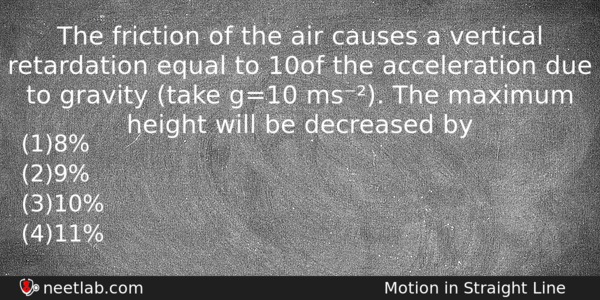| ⇦ | 
| ⇨ |
The friction of the air causes a vertical retardation equal to 10% of the acceleration due to gravity (take g=10 ms⁻²). The maximum height will be decreased by
Options
(a) 8%
(b) 9%
(c) 10%
(d) 11%
Correct Answer:
9%
Explanation:
Retardation due to friction of air = 8/10. Hence, in upward motion
Total retardation = g + (8/10) = 11g / 10
.·. H(m) = u² sin² θ / 2g
H(m)’ = u² sin² θ / 2×(11g/10) = (10/11)×(u² sin² θ / 2g) = (10/11) H(m)
.·. % decreases in H(m) = {[H(m) – H(m)’] / H(m)} × 100
= [1 – (10/11)] × 100 = 9%
Related Questions: - A small signal voltage V(t)=V₀ sin ωt is applied across an ideal capacitor C
- When radiation is incident on a photoelectron emitter,
- Electrical force is acting between two charges kept in vacuum. A copper plate
- The manifestation of band structure in solids is due to
- Dimensions of Torque are
Topics: Motion in Straight Line
(93)
Subject: Physics
(2479)
Important MCQs Based on Medical Entrance Examinations To Improve Your NEET Score
- A small signal voltage V(t)=V₀ sin ωt is applied across an ideal capacitor C
- When radiation is incident on a photoelectron emitter,
- Electrical force is acting between two charges kept in vacuum. A copper plate
- The manifestation of band structure in solids is due to
- Dimensions of Torque are
Topics: Motion in Straight Line (93)
Subject: Physics (2479)
Important MCQs Based on Medical Entrance Examinations To Improve Your NEET Score
18000+ students are using NEETLab to improve their score. What about you?
Solve Previous Year MCQs, Mock Tests, Topicwise Practice Tests, Identify Weak Topics, Formula Flash cards and much more is available in NEETLab Android App to improve your NEET score.
Share this page with your friends

Leave a Reply